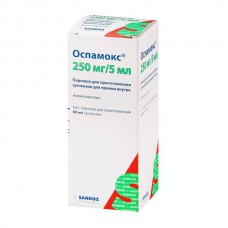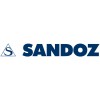Expiration date: 05/2026
Composition and form of issue:
1 capsule contains amoxicillin 250 mg in a blister 10 PCs.
1 tablet coated-500 mg blister 10 or 12 PCs., in a cardboard box 100 or 1 blister and 1000 mg blister 10 or 12 PCs., in a cardboard box 100 or 1 blister.
Granules for preparation of the suspension for oral administration-125 mg/5 ml in 60 ml bottles in a box of 1 or 40 bottles or 250 mg / 5 ml in 60 ml bottles in a box of 1 or 40 bottles.
Pharmacological action:
Blocks synthesis of peptidoglycan of the shell of sensitive microorganisms and causes their death.
Pharmacokinetics:
Almost completely absorbed in the small intestine (food intake does not affect absorption), Cmax is achieved in 1-2 hours Distributed in tissues and body fluids, including sputum and purulent bronchial secretion, it passes into breast milk. In normal liver there is a high concentration in bile. T1 / 2— 1-2 h, excreted mainly by the kidneys (50% in the active form).
Description of the pharmacological action:
Active against gram-positive and gram-negative bacteria. Does not affect microorganisms that produce penicillinase, Pseudomonas, Klebsiella, indole-positive Proteus, Enterobacter.
Indications:
Infections of the lower (acute, chronic bronchitis, pneumonia, lung abscess, whooping cough) and upper respiratory tract, ENT organs, genitourinary organs (acute, chronic pyelonephritis, pyelitis, prostatitis, epididymitis, cystitis, urethritis, asymptomatic bacteriuria during pregnancy, gonorrhea), gastrointestinal tract (typhoid, paratyphoid, cholangitis, cholelythiasis, skin) soft tissues, gynecological (endometritis, etc.) leptospirosis, listeriosis, infectious endocarditis, meningitis, septicemia, prevention of surgical infection.
Contraindications:
Hypersensitivity (including to other penicillin antibiotics), severe infections of the gastrointestinal tract, accompanied by diarrhea or vomiting, mononucleosis, lymphocytic leukemia.
Application for pregnancy and breastfeeding:
Perhaps, if the expected effect of therapy exceeds the potential risk to the fetus. At the time of treatment should stop breastfeeding.
Side effect:
From the digestive tract: glossitis, stomatitis, nausea, diarrhea, pseudomembranous colitis.
From the nervous system and sensory organs:headache, weakness, seizures.
From the cardiovascular system and blood (hematopoiesis, hemostasis):agranulocytosis, leukocytosis, thrombocytopenia, eosinophilia.
Allergic reactions: hypersensitivity reactions, anaphylactic shock, urticaria, Quincke edema.
From the skin: erythema multiforme, exfoliative dermatitis.
Other: superinfections, interstitial nephritis, joint pain, transient increase in aminotransferase activity.
Drug interaction:
Effect weaken bacteriostatic drugs and antacids, increase the aminoglycosides and metronidazole. Reduces the effect of estrogens-containing oral contraceptives, reduces Cl and increases the toxicity of methotrexate, increases the absorption of digoxin. Probenecid and other drugs that suppress tubular secretion, slow down excretion, allopurinol-increases the risk of skin rashes.
Method of application and doses:
Inside, drinking plenty of water. Adults and adolescents — 1500-2000 mg/day children — at the rate of 30-60 mg/kg/day. Treatment continues for 2-5 days after the disappearance of symptoms. At streptococcal infection-not less than 10 days. Average doses are given in the table:
Age | Dose | Release form | |
Children | up to 1 year | 1 scoop 2 times a day | 125mg/5ml granules |
1–6 years | 1-1. 5 scoops 2 times a day | 250 mg/5 ml granules | |
6–10 years | on 1, 5-2 measuring spoon 2 times a day | 250 mg/5 ml granules | |
10–14 years | 1 table. 2 times a day | 500 ?? ????. | |
Teenagers | on 1, 5 table. 2 times a day | 500 ?? ????. | |
Adults | 1 table. 2 times a day | 1000 ?? ????. | |
In severe disease daily dose is increased: adults up to 6000 mg / day and children up to 100 mg/kg / day. Adults with acute infections of the gastrointestinal tract (typhoid fever, paratyphoid) and biliary tract, accompanied by an increase in body temperature, gynecological infections: 1500-2000 mg 3 times a day or 1000-1500 mg 4 times a day, leptospirosis-500-750 mg 4 times a day for 6-12 days, chronic salmonellosis — carrier) - 1500-2000 mg 3 times a day for 2-4 weeks. Secondary prevention of endocarditis during dental extractions:adults: 3,000 to 4,000 mg 1 hour prior to the intervention, if necessary, re — using 8-9 h children designate 1/2 the adult dose.
In violation of kidney function (Cl creatinine 15-40 ml/min)appointed at intervals of 12 h, in patients with anuria more than 2000 mg / day.
Precautionary measures:
With caution appoint patients with allergic diathesis, bronchial asthma, hay fever. Long-term therapy requires monitoring of liver and kidney function, blood cell composition. Patients with suspected concomitant syphilis should conduct serological studies in dynamics for 4 months.
Special instruction:
It should be borne in mind that the granules for the preparation of suspensions contain sugar. When determining glucose in the urine may falsely positive results and change the results to determine urobilinogena.


